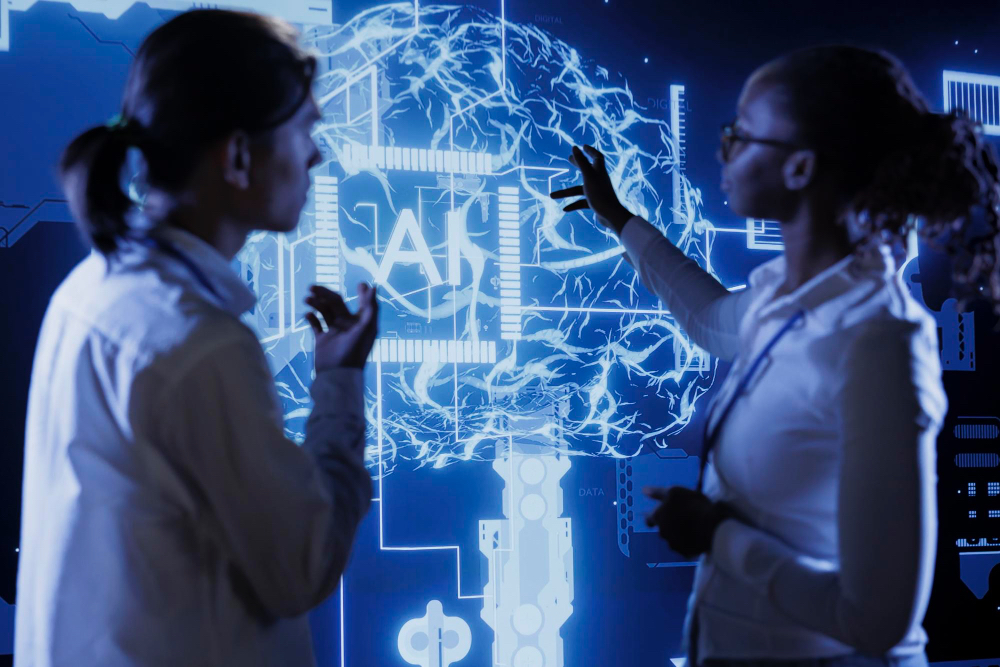- Mail:
- info@digital4pro.com
AI: Strategie per l’implementazione nelle organizzazioni

La Legge 90/2024 sulla Cybersicurezza: gli adempimenti per P.A. e società private
23 Dicembre 2024
AI: Le origini
8 Gennaio 2025L’introduzione dell’intelligenza artificiale nelle organizzazioni è un’operazione piuttosto complessa. Come vale per tutte leinnovazioni, è infatti necessario del tempo prima di poter usufruire appieno dei vantaggi che questa apporta. Inoltre, occorre superare diversi ostacoli prima di arrivare alla sua efficace applicazione.
1 Criticità
Le principali criticità da fronteggiare nell’introduzione dell’intelligenza artificiale nelle organizzazioni sono[1]:
- Costi per hardware e software: l’implementazione dell’intelligenza artificiale richiede lo sviluppo di hardware e software ad alte prestazioni, che generalmente hanno un costo elevato. Per limitare le spese, una possibile soluzione è quella di rivolgersi a fornitori esterni in possesso degli strumenti e delle competenze adeguate;
- Costi per la formazione del personale: per sfruttare appieno i benefici derivanti dall’impiego di questa tecnologia, occorre attivare un insieme di competenze adeguate nei dipendenti. In questo senso, per prima cosa, è opportuno considerare le modalità tramite cui l’avvento di questa innovazione modifica l’attività lavorativa. Sulla base di ciò, poi le organizzazioni hanno due soluzioni principali a loro disposizione: da un lato, possono assumere dall’esterno individui che sono già in possesso delle skills necessarie; dall’altro, possono darvita a programmi di formazione variegati, basati su libri, audiolibri, video, podcast, corsi online e interventi di coaching[2];
- Necessità di dataset ampi: le soluzioni aziendali basate sull’intelligenza artificiale dovrebbero essere programmate per gestire, analizzare ed elaborare grandi quantità di Quindi, per le organizzazioni èimportante aumentare la capacità di raccolta e archiviazione dei dati;
- Etichettatura dei dati: la grande quantità di dati generata quotidianamente rende complessa la loro etichettatura. Quest’ultima è un’operazione cruciale per organizzare i dati e per estrapolare informazioni dagli stessi;
- Carenza di personale specializzato: le figure esperte di intelligenza artificiale non sono numerose, ma sono fondamentali per implementare con successo soluzioni aziendali basate su questa tecnologia.
2 Strategie
È possibile individuare diverse strategie tramite le quali introdurre l’intelligenza artificiale all’interno delle organizzazioni,ciascuna delle quali presenta dei vantaggi e dei limiti[3].
2.1 Applicare l’AI a processi esistenti
Una prima possibile soluzione è data dall’applicazione di questa tecnologia ad un processo già esistente al fine diautomatizzarlo e di migliorarlo in termini di costi e velocità. Tuttavia, secondo alcuni esperti, questo approccio presenta alcune problematiche quali la maggiore difficoltà e i maggiori costi da sostenere per portare l’intelligenza artificiale alla scala ideale.
2.2 Ristrutturare l’organizzazione aziendale in funzione dell’AI
Un altro approccio possibile, ma caratterizzato da elevata complessità, prevede di ristrutturare l’intera organizzazione in funzione dell’intelligenza artificiale in un unico passaggio.
Una trasformazione completa di questo tipo è un procedimento estremamente complesso che richiede il coinvolgimento di tutte le aree organizzative contemporaneamente. Per questo motivo, secondo alcuni studiosi, tale tecnica richiedemolto tempo prima di produrre i benefici desiderati.
2.3 Ripensare il modello di business e modificare le modalità operative
La soluzione ritenuta migliore da molti esperti presuppone un cambiamento organizzativo caratterizzato da due attivitàcruciali: ripensare il modello di business preesistente per renderlo più funzionale all’innovazione tecnologica e modificare le modalità con cui viene svolta l’attività quotidiana.
In particolare, l’implementazione dell’intelligenza artificiale dovrebbe avvenire in maniera graduale, focalizzandosi dapprima su un’area aziendale o su un processo chiave per poi espandersi successivamente. In questa maniera è possibile monitorare l’influenza che l’adozione di questa tecnologia esercita progressivamente sulle variabiliorganizzative, quali l’organizzazione del lavoro e la cultura aziendale.
Tale approccio strategico prevede quindi di identificare una parte cruciale del business aziendale e di ripensarla integralmente. In questo modo si possono ottenere benefici a livello di performance e anche per quanto riguarda il coinvolgimento della forza lavoro.
Nello specifico, questa soluzione è caratterizzata da 4 fasi principali[4]:
- Definire la strategia generale: l’obiettivo finale non è la semplice adozione dell’intelligenza artificiale, ma la sua concreta applicazione in azienda al fine di ottenere un vantaggio competitivo. Di conseguenza, i CEO delle organizzazioni hanno un ruolo cruciale nell’individuazione delle aree aziendali nelle quali essa può produrre vantaggi significativi in un breve lasso di tempo. In questa scelta i leader potrebbero contare anche sull’ausilio di un così detto CAIO[5], ossia un Chief Artificial Intelligence Officer. Questa figura lavora trasversalmente ai confini delle unità organizzative per identificare le aree dove può essere introdotta questa Inoltre, definisce le strategie, coordina i progetti e recluta altri specialisti sulla tematica. Per scegliere la soluzione migliore, occorre valutare la fattibilità del progetto e il valore economico che potenzialmente può essere creato.Per esempio, il gruppo automobilistico tedesco BMW ha introdotto l’intelligenza artificiale perché riteneva che essa potesse rivestire un ruolo cruciale nel processo di trasformazione digitale dell’azienda. In particolare, l’adozione di questa tecnologia ha permesso di migliorare la customer experience, di sviluppare nuovi prodotti edi comprendere meglio alcuni processi aziendali[6];
- Formare un team: è opportuno che il compito di applicare la tecnologia venga affidato a un team composto da più figure: un responsabile dell’intero progetto, che supervisiona tutte le varie fasi; un senior business staff, che coordina le competenze di business con quelle tecnologiche e che è responsabile dei cambiamenti nelle pratiche di management; dei professionisti di intelligenza artificiale come business analysts ed esperti di data science, i quali svolgono un ruolo fondamentale per introdurre con successo questa tecnologia nelleorganizzazioni; un insieme di dipendenti in prima linea che si occupano delle attività Pertanto, sirende necessario coinvolgere persone con differenti competenze e affidare loro la responsabilità del progetto. La disponibilità di abilità trasversali, infatti, consente di fronteggiare con entusiasmo gli ostacoli che sipresenteranno. Infine, un altro aspetto cruciale è dato dalla necessità di sviluppare un forte senso di appartenenza e di coinvolgimento nel team. In questa maniera si ottiene anche un’elevata coesione, caratteristica che risulta essere cruciale per comunicare apertamente, imparare dai feedback ricevuti e perseguire gli obiettivi comuni;
- Ripensare il modello di business: per sfruttare al meglio i benefici dell’innovazione tecnologica occorre non soloreinventare il modello di business, ma anche ripensare completamente i ruoli, le responsabilità e i processi, cambiando radicalmente il modo di pensare e di I team precedentemente descritti dovrebbero ricercare le principali problematiche dell’area aziendale prescelta dal CEO e determinare le modalità perrisolverle tramite l’implementazione dell’intelligenza artificiale;
- Promuovere il cambiamento organizzativo e tecnologico: le organizzazioni che traggono i maggiori benefici dall’introduzione dell’intelligenza artificiale, in genere, si rendono protagoniste di notevoli cambiamenti nelle pratiche di management, con i leader aziendali che diffondono i comportamenti desiderati al resto del Un altro aspetto fondamentale è rappresentato dalla riqualificazione del personale, necessaria per istruire i lavoratori già presenti in azienda a usufruire delle nuove tecnologie. Infine, occorre effettuare notevoli investimenti dal punto di vista tecnologico per mettere a punto e portare alla scala ideale l’intelligenza artificiale.
Una volta che l’uso dell’intelligenza artificiale si è sviluppato con successo in una determinata area aziendale, allora è possibile estendere il suo impiego in altre parti dell’organizzazione secondo un processo graduale. A questo punto,infatti, le competenze tecnologiche e organizzative acquisite sono solide e pronte per essere trasferite in altre zone.
Ovviamente, è presumibile che la successiva applicazione di questa tecnologia avvenga inizialmente in aree simili rispetto a quella originariamente interessata, in modo tale da sfruttare conoscenze già formate e valide. Inoltre, occorre considerare il fatto che la fase più complessa è la formazione iniziale delle competenze sull’intelligenza artificiale. Una volta sviluppate, queste possono rapidamente evolvere e ampliare gradualmente il loro raggio di azione.
Occorre precisare che l’approccio appena descritto prevede uno sviluppo esclusivamente interno di questa innovazionetecnologica. Oltre a questa opzione, vi è anche quella che prevede l’esternalizzazione dello sviluppo di soluzioni basate sull’intelligenza artificiale. Questa tecnica viene selezionata in caso di mancanza delle conoscenze e delle esperienze necessarie all’interno dell’organizzazione. Questa situazione non è rara vista la già sottolineata carenza di talentiinformatici disponibili sul mercato.
Conclusioni
In conclusione, si riassumono i punti salienti individuati dagli esperti nell’approccio strategico migliore per implementarel’intelligenza artificiale nelle organizzazioni.
- Per prima cosa, si sottolinea l’importanza del CEO, il quale, sfruttando la conoscenza del business in cui opera la propria azienda, individua l’area in cui l’innovazione tecnologica può potenzialmente produrre i benefici maggiori.
- Poi, si evidenzia come l’introduzione dell’intelligenza artificiale sia un processo graduale, che determina un ripensamento del modello di business e del modo di lavorare.
- Inoltre, è opportuno coinvolgere dipendenti con competenze e conoscenze differenti al fine di fronteggiare gli ostacoli del processo.
- Infine, è necessario mettere in atto alcuni cambiamenti organizzativi, che riguardano principalmente la struttura organizzativa, la cultura aziendale e l’organizzazione del lavoro.
Questi aspetti saranno analizzati dettagliatamente nei nostri prossimi articoli.
Bibliografia
- Agrawal, A., Gans, J., & Goldfarb, A. (2017). The trade-off every AI company will face.
- Harvard Business Review Digital Articles.
- Aspan, M. (2020). Siri, Did I Ace the Interview? Fortune International (Europe), 181(2).
- Bhimani, A., & Willcocks, L. (2014). Digitisation, Big Data and the transformation of accounting information. Accounting and Business Research, Taylor & Francis, Vol. 44 No. 4.
- Brundage, M., Avin, S., Clark, J., Toner, H., Eckersley, P., Garfinkel, B., … & Amodei, D. (2018). The malicious use of artificial intelligence: Forecasting, prevention, and mitigation. arXiv preprint arXiv:1802.07228.
- CGMA (2016). Business Analytics And Decision Making. Baseline.
- Costa, G., & Gianecchini, M. (2019). Risorse umane: persone, relazioni e valore (Vol. 454). McGraw-Hill.
- Craigen, D., Diakun-Thibault, N., & Purse, R. (2014). Defining cybersecurity. Technology Innovation Management Review, 4(10).
- Daft, R. L. (2017). Organizzazione aziendale. Sesta edizione. Daft, R. L. (2021). Organizzazione aziendale. Maggioli, Milano.
- Davenport, T., Guha, A., & Grewal, D. (2021). How to Design an AI Marketing Strategy: What the Technology Can Do Today—and What’s Next. Harvard Business Review, 99, 42- 47.
- Davenport, T., Guha, A., Grewal, D., & Bressgott, T. (2020). How artificial intelligence will change the future of marketing. Journal of the Academy of Marketing Science, 48(1), 24- 42.
- Doke, D. (2021). Software AI. Recruiter.
- Forger, G. (2020). AI and IoT are ready for your warehouse. Logistics management (Highlands Ranch, Colo.: 2002).
- Fountaine, T., McCarthy, B., & Saleh, T. (2021). Getting AI to scale. Harvard Business Review.
- Galeotti, M., & Garzella, S. (Eds.). (2013). Governo strategico dell’azienda: Prefazione del Prof. Umberto Bertini. G Giappichelli Editore.
- Gambhir, B., & Bhattacharjee, A. (2021). Embracing the role of artificial intelligence in accounting and finance: contemplating the changing skillset expectations. Development and Learning in Organizations: An International Journal.
- Gregg, M. (2005). CISSP security-management practices. Upper Saddle River, NJ: Pearson Education.
- Haenlein, M., & Kaplan, A. (2019). A brief history of artificial intelligence: On the past, present, and future of artificial intelligence. California management review, 61(4), 5-14.
- Harrison, N., & O’Neill, D. (2017). If your company isn’t good at analytics, it’s not ready for AI. Harvard Business Review.
- Henke, N., Levine, J., & McInerney, P. (2018). You don’t have to be a data scientist to fill this must-have analytics role. Harvard Business Review.
- Huang, M. H., Rust, R., & Maksimovic, V. (2019). The feeling economy: Managing in the next generation of artificial intelligence (AI). California Management Review, 61(4), 43-65.
- Lichtenthaler, U. (2020). Mixing data analytics with intuition: Liverpool Football Club scores with integrated intelligence. Journal of Business Strategy.
- Luo, X., Qin, M. S., Fang, Z., & Qu, Z. (2021). Artificial intelligence coaches for sales agents: Caveats and solutions. Journal of Marketing, 85(2), 14-32.
- McAfee, A., & Brynjolfsson, E. (2012). Big data: the management revolution. Harvard business review, 90(10), 60-68.
- Miyashita, M., & Brady, M. (2019). The Health Care Benefits of Combining Wearables and AI. Harvard Business Review.
- Nair, K., & Gupta, R. (2021). Application of AI technology in modern digital marketing environment. World Journal of Entrepreneurship, Management and Sustainable Development.
- Niehueser, W., & Boak, G. (2020). Introducing artificial intelligence into a human resources function. Industrial and commercial training, 52(2), 121-130.
- Ore, O., & Sposato, M. (2021). Opportunities and risks of artificial intelligence in recruitment and selection. International Journal of Organizational Analysis.
- Paschen, J., Kietzmann, J., & Kietzmann, T. C. (2019). Artificial intelligence (AI) and its implications for market knowledge in B2B marketing. Journal of Business & Industrial Marketing.
- Paschen, U., Pitt, C., & Kietzmann, J. (2020). Artificial intelligence: Building blocks and an innovation typology. Business Horizons, 63(2), 147-155.
- Petkov, R. (2020). Artificial intelligence (AI) and the accounting function—A revisit and a new perspective for developing framework. Journal of emerging technologies in accounting, 17(1), 99-105.
- Pighin, M., & Marzona, A. (2018). Sistemi informativi aziendali: ERP e sistemi di data analysis.
- Poba-Nzaou, P., Galani, M., Uwizeyemungu, S., & Ceric, A. (2021). The impacts of artificial intelligence (AI) on jobs: an industry perspective. Strategic HR Review, 20(2), 60- 65.
- Ponnapalli, P. (2022). Keys to successful innovation through artificial intelligence. Harvard Business Review.
- Ransbotham, S., Candelon, F., Kiron, D., LaFountain, B., & Khodabandeh, S. (2021). The Cultural Benefits of Artificial Intelligence in the Enterprise. MIT Sloan Management Review and Boston Consulting Group.
- Rudko, I., Bashirpour Bonab, A., & Bellini, F. (2021). Organizational structure and artificial intelligence. Modeling the intraorganizational response to the ai contingency. Journal of Theoretical and Applied Electronic Commerce Research, 16(6), 2341-2364.
- Samonas, S., & Coss, D. (2014). The CIA strikes back: Redefining confidentiality, integrity and availability in security. Journal of Information System Security, 10(3).
- Shrestha, Y. R., Ben-Menahem, S. M., & Von Krogh, G. (2019). Organizational decision- making structures in the age of artificial intelligence. California Management
- Review, 61(4), 66-83.
- Simonovich, L. (2021). Balancing AI advances with robust cybersecurity solutions. World Oil.
- Soni, V. D. (2020). Challenges and Solution for Artificial Intelligence in Cybersecurity of the USA. Available at SSRN 3624487.
- Strubell, E., Ganesh, A., & McCallum, A. (2019). Energy and policy considerations for deep learning in NLP. arXiv preprint arXiv:1906.02243.
- Tabesh, P. (2021). Who’s making the decisions? How managers can harness artificial intelligence and remain in charge. Journal of Business Strategy.
- S (2021). 3 areas where AI will boost your competitive advantage. Harvard Business Review Digital Articles.
- Truong, T. C., Zelinka, I., Plucar, J., Čandík, M., & Šulc, V. (2020). Artificial intelligence and cybersecurity: Past, presence, and future. In Artificial intelligence and evolutionary computations in engineering systems (pp. 351-363). Springer, Singapore.
- Tschang, F. T., & Almirall, E. (2021). Artificial intelligence as augmenting automation: Implications for employment. Academy of Management Perspectives, 35(4), 642-659.
- Tse, T., Esposito, M., Takaaki, M., & Goh, D. (2020). The dumb reason your AI project will fail. Harvard business review digital articles, 2-5.
- Vadari, S., & Desik, P. A. (2021). The Role of AI/ML in Enhancing Knowledge Management Systems. IUP Journal of Knowledge Management, 19(2), 7-31.
- Wamba-Taguimdje, S. L., Wamba, S. F., Kamdjoug, J. R. K., & Wanko, C. E. T. (2020). Influence of artificial intelligence (AI) on firm performance: the business value of AI-based transformation projects. Business Process Management Journal, 26(7), 1893-1924.
- Whitmore, A., Agarwal, A., & Da Xu, L. (2015). The Internet of Things—A survey of topics and trends. Information systems frontiers, 17(2), 261-274.
- Yampolskiy, R. V. (2017). AI Is the Future of Cybersecurity, for Better and for Worse. Harvard Business Review. May, 8.
- Zaki, M., McColl-Kennedy, R., & Neely, A. (2021). Using AI to Track How Customers Feel—In Real Time. Harvard Business Review.
- Zhang, H., Zhang, X., & Song, M. (2021). Deploying AI for New Product Development Success: By embracing and incorporating AI in all stages of NPD, companies can increase their success rate of NPD projects. Research-Technology Management, 64(5), 50-57.
- Zouave, E., Gustafsson, T., Bruce, M., Colde, K., Jaitner, M., & Rodhe, I. (2020). Artificially intelligent cyberattacks. Swedish Defence Research Agency, FOI, Tech. Rep. FOI.
- (2017). Lavazza a caccia di “coffe addicted” con l’intelligenza artificiale. Il Sole 24 Ore. Retrieved from https://www.ilsole24ore.com/art/lavazza-caccia-coffee-addicted-l- intelligenza-artificiale–AEBRpxQD 2022/08/02
- Amar, J., Majumder, S., Surak, Z., & von Bismarck, N. (2021). How AI-driven nudges can transform an operation’s performance. McKinsey Global Institute. Retrieved from https://www.mckinsey.com/business-functions/operations/our-insights/how-ai-driven- nudges-can-transform-an-operations-performance 2022/07/27
- Balabio, B., Orlando, P., & Scolari, T. (2021). Cresce il mercato dell’intelligenza artificiale in Italia. Retrieved from https://www.osservatori.net/it/ricerche/comunicati- stampa/artificial-intelligence-italia-mercato-progetti-2020 2022/07/08
- Berruti, F., Nel, P., & Whiteman R. (2020). An executive primer on artificial general intelligence. McKinsey Global Institute. Retrieved from https://www.mckinsey.com/business-functions/operations/our-insights/an-executive- primer-on-artificial-general-intelligence 2022/07/06
- Boehm, J., Curcio, N., Merrath, P., Shenton, L., & Stahle T. (2019). The risk-based approach to cybersecurity. McKinsey Global Institute. Retrieved from https://www.mckinsey.com/business-functions/risk-and-resilience/our-insights/the-risk- based-approach-to-cybersecurity 2022/08/03
- Brooks, C. (2022). Alarming cyber statistics for mid-year 2022 that you need to know. Forbes. Retrieved from https://www.forbes.com/sites/chuckbrooks/2022/06/03/alarming- cyber-statistics-for-mid-year-2022-that-you-need-to-know/?sh=7043d0247864 2022/08/03
- Brown, S., Gandhi, D., Herring, L., & Puri, A. (2019). The analytics academy: bridging the gap between human and artificial intelligence. McKinsey Global Institute. Retrieved from https://www.mckinsey.com/business-functions/mckinsey-analytics/our-insights/the- analytics-academy-bridging-the-gap-between-human-and-artificial-intelligence 2022/07/18
- Buehler, K., Dooley, R., Grennan, L., & Singla, A. (2021). Getting to know-and manage- your biggest AI risks. McKinsey Global Institute. Retrieved from https://www.mckinsey.com/business-functions/mckinsey-analytics/our-insights/getting-to- know-and-manage-your-biggest-ai-risks 2022/07/11
- Bughin, J., Seong, J., Manyika, J., Chui, M., & Joshi, R. (2018). Notes from the AI frontier: Modeling the impact of AI on the world economy. McKinsey Global Institute. Retrieved from https://www.mckinsey.com/featured-insights/artificial-intelligence/notes-from-the-ai- frontier-modeling-the-impact-of-ai-on-the-world-economy#part1 2022/07/15
- Chakraborty, A. (2021). A.I. can be a cornerstone of success – but only if leaders make the right choices. Fortune. Retrieved from https://fortune.com/2021/10/27/ai-artificial- intelligence-business-strategy-data-accenture/ 2022/07/29
- Chui, M., Hall, B., Singla, A., & Sukharevsky, A. (2021). The state of AI in 2021. McKinsey Global Institute. Retrieved from https://www.mckinsey.com/business- functions/quantumblack/our-insights/global-survey-the-state-of-ai-in-20212022/07/08
- Chui, M., Manyika, J., Miremadi, M., Henke, N., Chung, R., Nel, P., & Malhotra, S. (2018). Notes from the AI frontier: Applications and value of deep learning. McKinsey global institute discussion paper, April. Retrieved from https://www.mckinsey.com/featured- insights/artificial-intelligence/notes-from-the-ai-frontier-applications-and-value-of-deep- learning 2022/07/07
- Dandona, G. S., Sharma, J., & Wright, M. (2021). Our own digital journey: upskilling hundreds of McKinsey technologists in AI. McKinsey Global Institute. Retrieved from https://www.mckinsey.com/about-us/new-at-mckinsey-blog/ai-upskilling-for-over-500- firm-technologists 2022/07/19
- Fowler, G. (2020). AI and its potential for cybersecurity. Forbes. Retrieved from https://www.forbes.com/sites/forbesbusinessdevelopmentcouncil/2020/12/18/ai-and-its- potential-for-cybersecurity/?sh=5d2f609e69d9 2022/08/03
- https://assets.siemens-energy.com/siemens/assets/api/uuid:cf20f2e1-ca9c-4589-9f88- 4e6592b4672d/brochure-deeparmour-industrial-200609.pdf 2022/08/05
- https://bids.berkeley.edu/news/berkeley-institute-data-science-and-accenture-applied- intelligence-announce-new-collaboration 2022/07/18
- https://info.algorithmia.com/hubfs/2020/Reports/2021-Trends-in- ML/Algorithmia_2021_enterprise_ML_trends.pdf?hsLang=en-us 2022/07/08
- https://wwd.com/business-news/technology/levis-ai-bootcamp-data-science-1234881378/ 22/09/04
- https://www.accenture.com/_acnmedia/PDF-63/Accenture-CoBE-Brochure-
- pdf#zoom=50 2022/08/23
- https://www.accenture.com/fr-fr/_acnmedia/36dc7f76eab444cab6a7f44017cc3997.pdf 2022/07/08
- https://www.bcg.com/publications/2020/is-your-company-embracing-full-potential-of- artificial-intelligence 2022/09/17
- https://www.capgemini.com/wp-content/uploads/2019/07/AI-in- pdf 2022/08/03
- https://www.careers.ox.ac.uk/article/the-pymetrics-games-overview-and-practice- guidelines 2022/07/26
- https://www.cnr.it/sites/default/files/public/media/attivita/editoria/VOLUME%20FULL%20 14%20digital%20LIGHT.pdf 2022/08/22
- https://www.levistrauss.com/2021/05/17/machine-learning-bootcamp/ 2022/07/19
- https://www.linkedin.com/pulse/how-coca-cola-using-ai-stay-top-soft-drinks-market- shivani-salunkhe 2022/08/23
- https://www.mckinsey.com/about-us/new-at-mckinsey-blog/mckinsey-receives-top- ranking-in-the-forrester-wave-ai-report 2022/07/19
- https://www.nist.gov/system/files/documents/cyberframework/cybersecurity-framework- pdf 2022/08/03
- https://www.statista.com/statistics/1083482/worldwide-ai-revenue-increase/ 2022/08/02 https://www.statista.com/statistics/1083516/worldwide-ai-cost-decrease/ 2022/08/02
- https://www.statista.com/statistics/1119824/global-business-and-hr-leaders-on-ai-impact- to-job-numbers/ 2022/07/20
- https://www.statista.com/statistics/1235395/worldwide-ai-enabled-cyberattacks- companies/ 2022/08/05
- https://www.statista.com/statistics/1293758/ai-marketing-revenue-worldwide/ 2022/07/25
- https://www.statista.com/statistics/472934/business-analytics-software-revenue- worldwide/ 2022/07/29
- https://www.statista.com/statistics/871513/worldwide-data-created/ 2022/07/29
- https://www.statista.com/statistics/941137/ai-investment-and-funding-worldwide/ 2022/07/08
- https://www.treccani.it/enciclopedia/intelligenza-artificiale 2022/07/04
- https://www.treccani.it/enciclopedia/sicurezza-informatica/#:~:text=sicur%C3%A9zza%20inform%C3%A0tica%20Ramo%20dell’informatica,dati%20riservati%20in%20essi%20contenuti. 2022/09/13
- https://www.tripwire.com/state-of-security/security-data-protection/43-billion-stolen- through-business-email-compromise-since-2016-reports-fbi/ 2022/09/13
- https://www.webfx.com/martech/pricing/ai/#:~:text=In%202020%2C%20companies%20can%20pay,house%20or%20freelance%20data%20scientists.&text=In%20comparison
- %2C%20custom%20AI%20solutions,from%20%246000%20to%20over%20%24300%2C 000. 2022/09/18
- Jeans, D. (2020). Companies will spend $50 billion on artificial intelligence this year with little to show for it. Forbes. Retrieved from https://www.forbes.com/sites/davidjeans/2020/10/20/bcg-mit-report-shows-companies- will-spend-50-billion-on-artificial-intelligence-with-few-results/?sh=7efe3fe57c87 2022/09/17
- Johar, P. (2020). How AI makes big data smarter. Forbes. Retrieved from https://www.forbes.com/sites/forbestechcouncil/2020/03/23/how-ai-makes-big-data- smarter/?sh=381f9b6a4684 2022/08/01
- Luchtenberg, D., & Migliorini, R. (2022). Coca-Cola: The people-first story of a digital transformation. McKinsey Global Institute. Retrieved from https://www.mckinsey.com/business-functions/operations/our-insights/coca-cola-the- people-first-story-of-a-digital-transformation 2022/08/02
- Malins, A. (2022). Machine learning and artificial intelligence: implementation in practice. Forbes. Retrieved from https://www.forbes.com/sites/forbestechcouncil/2022/01/25/machine-learning-and- artificial-intelligence-implementation-in-practice/?sh=7692b2a35c89 2022/07/15
- Manyika J., & Sneader K. (2018). AI, automation, and the future of work: Ten things to solve for. McKinsey Global Institute. Retrieved from https://www.mckinsey.com/featured- insights/future-of-work/ai-automation-and-the-future-of-work-ten-things-to-solve-for 2022/07/15
- Marr, B. (2017). The Amazing Ways Coca Cola Uses Artificial Intelligence And Big Data To Drive Success. Forbes. Retrieved from https://www.forbes.com/sites/bernardmarr/2017/09/18/the-amazing-ways-coca-cola- uses-artificial-intelligence-ai-and-big-data-to-drive-success/?sh=1448c01778d2 2022/08/02
- Marr, B. (2018). The amazing ways how Unilever uses artificial intelligence to recruit & train thousands of employees. Forbes. Retrieved from https://www.forbes.com/sites/bernardmarr/2018/12/14/the-amazing-ways-how-unilever- uses-artificial-intelligence-to-recruit-train-thousands-of-employees/?sh=485a1ca76274 2022/07/26
- Marr, B. (2022). The most in – demand technical skills – and how to develop them. Forbes. Retrieved from https://www.forbes.com/sites/bernardmarr/2022/08/03/the-most- in-demand-technical-skills–and-how-to-develop-them/?sh=7a1c4e1362e4 2022/08/22
- Mohan S. (2022). How to make it easier to implement AI in your business. Forbes. Retrieved from https://www.forbes.com/sites/forbestechcouncil/2022/05/27/how-to- make-it-easier-to-implement-ai-in-your-business/?sh=481bfbd65300 2022/07/12
- Rossitto, S. (2021). “Senza intelligenza artificiale e big data impossibile un vaccino contro il Covid in tempi brevi”. Il Sole 24 Ore. Retrieved from https://www.ilsole24ore.com/art/senza-intelligenza-artificiale-e-big-data-impossibile-vaccino-contro-covid-tempi-brevi-AD5lOYHB 2022/08/01
- Rusconi, G. (2022). L’intelligenza artificiale facilita il cambiamento organizzativo. Il Sole 24 Ore. Retrieved from https://www.ilsole24ore.com/art/l-intelligenza-artificiale-facilita- cambiamento-organizzativo-AEitC2OB 2022/07/14
- Sinur, J., & Peters, E. (2019). AI & big data; better together. Forbes. Retrieved from https://www.forbes.com/sites/cognitiveworld/2019/09/30/ai-big-data-better- together/?sh=61a9e9a360b3 2022/08/01
- Taulli, T. (2021). Artificial intelligence: should you teach it to your employees? Forbes. Retrieved from https://www.forbes.com/sites/tomtaulli/2021/09/10/ai-artificial- intelligence-should-you-teach-it-to-your-employees/?sh=2bab6b507b73 2022/07/18
- Tremolada, L. (2019). Machine learning, deep learning e reti neurali. Ecco di cosa parliamo. Il sole 24 ore. Retrieved from https://www.ilsole24ore.com/art/machine- learning-deep-learning-e-reti-neurali-ecco-cosa-parliamo–AEaToEBH2022/07/07
- ASIMOV, I. (1950), I, Robot. (Cited at page 5)
- BABBAGE, C. (1982), «On the Mathematical Powers of the Calculating Engine», The Origins of Digital Computers. Texts and Monographs in Computer Science.
- BODEN, M. A. (2018), Artificial Intelligence: A Very Short Introduction.
- CAMPBELL, M., HOANE, A. J. e HSIUNG HSU, F. (2002), «Deep Blue», Artificial Intelligence, vol. 134, p. 57–83.
- CLARKE, A. C. e KUBRICK, S. (1968), 2001: A Space Odyssey.
- DICK, P. K. (1968), Do Androids Dream of Electric Sheep?
- HASHEMIPOUR, S. e ALI, M. (2020), «Amazon Web Services (AWS) – An Overview of the On-Demand Cloud Computing Platform».
- KRIZHEVSKY, A., SUTSKEVER, I. e HINTON, G. E. (2012), «ImageNet classification with deep convolutional neural networks», Communications of the ACM, vol. 60, p. 84 – 90.
- LECUN, Y., BENGIO, Y. e HINTON, G. E. (2015), «Deep Learning», Nature, vol. 521, p. 436–444.
- MASLEJ, N., FATTORINI, L., BRYNJOLFSSON, E., ETCHEMENDY, J., LIGETT, K., LYONS, T., MANYIKA, J., NGO, H., NIEBLES, J. C., PARLI, V., SHOHAM, Y., WALD, R., CLARK, J., e PERRAULT, R. (2023), «The AI Index 2023 Annual Report», Rap. tecn., AI Index Steering Committee, Institute for Human-Centered AI, Stanford University, Stanford, CA.
- MCCARTHY, J. (1960), «Programs with common sense».
- MCCARTHY, J., MINSKY, M., ROCHESTER, N. e SHANNON, C. E. (2006), «A Proposal for the Dartmouth Summer Research Project on Artificial Intelligence, August 31, 1955», AI Mag., vol. 27, p. 12–14.
- RAO, A. S. e VERWEIJ, G. (2017), «Sizing the prize: what’s the real value of AI for your business and how can you capitalise?».
- RUSSELL, B. e WHITEHEAD, A. N. (1956), «Principia Mathematica to *56».
- RUSSELL, S. e NORVIG, P. (1995), «Artificial intelligence – a modern approach: the intelligent agent book».
- TURING, A. (1937), «On computable numbers, with an application to the Entscheidungsproblem», Proc. London Math. Soc.
- VASWANI, A., SHAZEER, N. M., PARMAR, N., USZKOREIT, J., JONES, L., GOMEZ, A. N., KAISER, L. e POLOSUKHIN, I. (2017), «Attention is All you Need», in «NIPS».
- freepik.com
Note
[1] Mohan S. (2022). How to make it easier to implement AI in your business. Forbes. Retrieved fromhttps://www.forbes.com/sites/forbestechcouncil/2022/05/27/how-to-make-it-easier-to-implement-ai-in- your-business/?sh=481bfbd65300 2022/07/12.
[2] Marr, B. (2022). The most in – demand technical skills – and how to develop them. Forbes. Retrieved fromhttps://www.forbes.com/sites/bernardmarr/2022/08/03/the-most-in-demand-technical-skills–and-how-to- develop-them/?sh=7a1c4e1362e4 2022/08/22.
[3] Fountaine, T., McCarthy, B., & Saleh, T. (2021). Getting AI to scale. Harvard Business Review, 119.
[4] Fountaine, T., McCarthy, B., & Saleh, T. (2021), op. cit., 119-123.
[5] Daft R. L. (2021), op. cit., 366.
[6] Ponnapalli, P. (2022). Keys to successful innovation through artificial intelligence. Harvard Business Review, 4.




